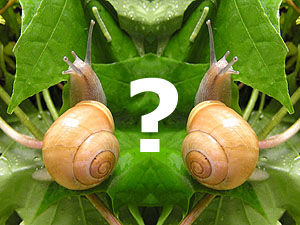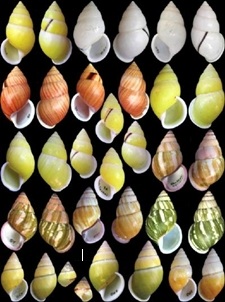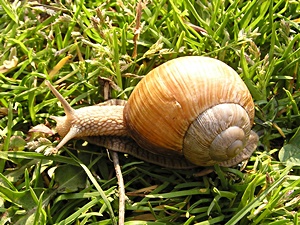
Right does not equal left. Snails may not be reflected, as their
shell is asymmetric. [RN]
 Right does not equal left. Snails may not be reflected, as their shell is asymmetric. [RN] |
In nature, there are numerous examples of the rule that right is rarely the same as left. One example of this chirality is the tetrahedral structure of the carbon atom. Another is the coiling of a snail's shell.
Basically, a shell, as snails have one, is a common character of all higher molluscs. As such, the shell is nothing special for a mollusc. What makes a snail's shell special, is the fact, that it is asymmetrically coiled to one direction, either left or right. Compared to a Nautilus's symmetrical shell, looking the same from left or right, the whorls of a snail's shell mount to a clearly visible tip - the apex - on one side of the animal.
If finally a snail's shell is coiled to the right or the left, is based on several factors.
which is why this species also is called a cheese snail. Upper and lower side, though, are very different. Picture: Helmut Nisters. |
The shell of Helicodonta obvoluta seems to look the same from above and below, flat and round like a loaf of cheese, which is why the species is also called cheese snail. However, upper and lower side of the shell are distinctly different, the upper side showing the spire of whorls, though without a clearly visible apex. On the lower side there is the shell's conspicuous navel, also called an umbilicus.
There is even a more difficult species in the Helicodontidae family: The sickle mouth snail (Drepanostoma nautiliforme) appears to have an umbilicus on either side of the shell. However, the snail itself remains asymmetric, the genital opening, for example, is on the right side of the body.
That means there is no geometrical mirror plane to divide the shell into two equal halves, which is why a snail's shell may not be reflected horizontally in a picture. The picture will then show something completely different.
![]() How to
determine
the coiling direction of a snail shell.
How to
determine
the coiling direction of a snail shell.
The coiling direction of the shell is basically so specific for a certain snail species, that it may be used for identification purposes. Often whole snail families are definite in this matter, such as the Helicidae, to which belong the largest land snail in Central and Western Europe, Helix pomatia. Helicids, like most snails, are dextral or right-handed.
(dextral), Cochlodina laminata und Macrogastra ventricosa, both sinistral. See text. Pictures: Helmut Nisters. |
In other snail groups, there may be a single sinistral among the larger part of dextral species. For the former, the sinistral is again specific in contrary to their relative species. For example, among the bulin snails (Enidae) with their characteristic towering shell, there is the large zebra snail (Zebrina detrita) from Southern Germany (the Kaiserstuhl area near Freiburg). Zebrina detrita is always dextral. Contrary to that, the four-toothed bulin, Jaminia quadridens, a smaller relative with four apertural teeth (hence the name), is always sinistral and is such opposed to the family rule.
The only land snail family with generally sinistral species are the door snails (Clausiliidae). Those small snails living on rocks and trees have got a spindle-shaped shell which makes it easy for them to hide from dryness in cracks and behind bark. They occur in an especially rich number of species on the Balkan peninsula and in Greece but are also spread of the rest of the Palaearctic (see zoogeographical faunal provinces). There are also door snails in Central and Western Europe, such as the plaited door snail (Cochlodina laminata) or the ventricose door snail (Macrogastra ventricosa), both of them sinistral. Contrary to that rule, there is the genus Alopia mainly occurring in Romania, that is, with some exceptions, dextral, as are some species of the Greek genus group Albinaria on the Peloponnesian peninsula.
![]() Hartmut Nordsieck:
Dextral Clausiliidae (Gastropoda, Stylommatophora), an evolutionary problem (hnords.de,
in print).
Hartmut Nordsieck:
Dextral Clausiliidae (Gastropoda, Stylommatophora), an evolutionary problem (hnords.de,
in print).
On the other hand, there are very few snail groups, in which sinistral (lef-handed) and dextral (right-handed) specimens occur at even rates. For example in the genus Amphidromus (Family Camaenidae), a large part of the species is sinistral (e.g. Amphidromus floresianus from Flores, Indonesia) and only some exceptions are dextral (e.g. Amphidromus kruehni from the Indonesian island of Sumba): Another species was even named Amphidromus inversus, because it is coiled to the right, opposite to most other Amphidromus species. The special thing about Amphidromus species, however, is that some species show the so-called amphidromy, which led to the genus' name: So, for example, Amphidromus butoti from Java is coiled to the left or to the right at about even rates.
 Amphidromus species from Thailand. (Source). The dash designates 10 mm. |
Amphidromus are arboreal snails, comparable to a Partula snail, but they are larger than those (between 25 and 75 mm) and they belong to another family (Camaenidae). Amphidromus are distributed from East India over Southeast Asia as far as Northern Australia. Because of the high amount of isolated insular populations, there are quite many species.
 A snail king (Helix pomatia). Enlarge! Snail king with dextral snail. as proof: Enlarge! Pictures: Robert Nordsieck. |
There is another very well-documented phenomenon in the Roman snail (Helix pomatia) species. Among thousands of dextral shells characteristic for the species, there may be one or the other rare sinistral specimen. Those then are colloquially referred to as snail kings.
![]() Snail Kings - Sinistral Helix Shells.
Snail Kings - Sinistral Helix Shells.
Of course sinistral specimens of dextral snail species not only may be found among Helix. From the Renaissance era shells like that have found their way into naturalists' collections as "conchylia sinistralia" and so can be found in natural history museums, which often enough evolved from those collections. Also among modern conchologists, sinistral shells are a very special addition to a shell collection, sometimes even a basis for specialisation.
Additional information:
![]() Benecke,
M. (1994): Von Schneckenkönigen, ungehörnten Würmern und schmatzenden Fischen.
Zur Systematik des Conchylienreiches. Club Conchylia 26(2):11-15.
Benecke,
M. (1994): Von Schneckenkönigen, ungehörnten Würmern und schmatzenden Fischen.
Zur Systematik des Conchylienreiches. Club Conchylia 26(2):11-15.
("Of snail kings, horn-less worms and smacking fish. Concerning the systematics
of shells" - in German).
Sinistral shells in collections:
![]() Carl Ruscoe (British Shell Collectors
Club):
An Insight Into Collecting Sinistral Shells.
Carl Ruscoe (British Shell Collectors
Club):
An Insight Into Collecting Sinistral Shells.
![]() Harry G. Lee (Jacksonville Shell Club):
Reverse coiled Gastropods.
Harry G. Lee (Jacksonville Shell Club):
Reverse coiled Gastropods.
A Japanese study of so-called Satsuma snails (Satsuma sp, Family Camaenidae) has found that in nature, sinistral specimens of the species are subject to a lower selection pressure by snail eating snakes (Pareas iwasakii). This snake species is adapted that well to preying on snails, they have more teeth on the jaw's right side to get a better grip in the snails' shells. That is why there are more sinistral specimens of Satsuma snails in areas where there are snail-eating snakes.
In Europe, there are no snail-eating snakes, also snail species in Europe are largely specific concerning the shell coiling direction
Additonal Information: